The heart of Cali, known worldwide as the capital of salsa, moved to the rhythm of tango in the Milongueando Tango Festival 2024. This 4-day event was an unforgettable experience that will fuse music, dance, and culture on a single stage. With its rich cultural heritage and a community passionate about dance, Cali is preparing to welcome tango artists and enthusiasts from all over the world.
The Milonga
Let’s start at the beginning. It all goes back to the tango tradition that exists and has continuously developed in Colombia.
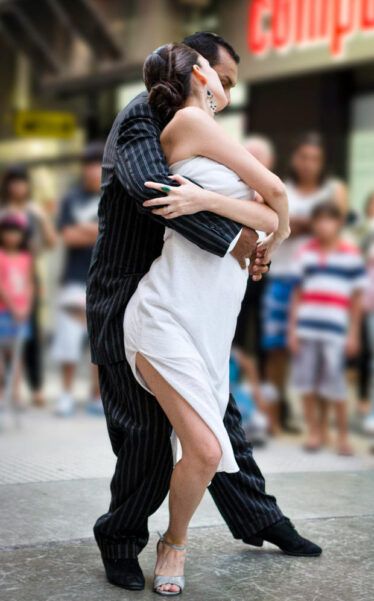
Tango arrived in Colombia in the early 20th century, brought by immigrants and travelers crossing the South American continent.
Quickly, this style of music and dance began to gain popularity in Colombia’s large cities.
In the 1920s and 1930s, the influence of tango was consolidated, especially in Medellín, which would become an epicenter of tango in Colombia.
The figure of Carlos Gardel, one of the greatest exponents of tango, has a special place in the history of tango in Colombia.
Gardel died tragically in a plane crash in Medellín in 1935, an event that, although painful, strengthened the bond between the city and tango.
Colombia hosts several tango festivals throughout the year. And, it is in this way that we come to the milonga.
The first thing to understand is that the milonga is a Rioplatense folk music genre typical of Argentina, Uruguay, and Rio Grande do Sul (Brazil). The genre comes from the gaucho culture.
Milonga is a term with multiple meanings within the tango world, but in general, it refers to three main things: a style of music and dance, a social event where tango is danced, and a musical form within tango. These meanings are explained in detail below:
Milonga, in the context of music, is a style that has a faster and more marked rhythm compared to traditional tango. It is characterized by its 2/4 time signature, which gives it a more lively feel. The lyrics of milonga songs are usually more festive and often contain a narrative or tell stories.
Milongas, social events where tango is danced, are art-filled events. These events not only allow dancers to practice and enjoy tango but also act as meeting points for the tango community.
Milonga dancing shares many characteristics with tango, but has its own set of steps and a faster tempo. The movements in milonga are generally shorter and faster, and the dance can be more relaxed and playful than tango. Dancers often use step patterns known as “cortes y quebradas,” which are more improvised and rhythmic movements.
It is important to note that in the context of social events, a milonga is a gathering or party where people get together to dance tango, milonga (the dance style), and vals criollo. These events usually take place in dance halls, tango clubs, and other spaces suitable for dancing. Milongas can vary in formality, from elegant events with dress codes to more informal and relaxed gatherings.

The social milonga has two key components:
*** The tandas and cortinas. The music in a milonga is organized in tandas, which are groups of three to four songs of the same style (tango, milonga, or waltz), followed by a cortina, which is a brief pause with non-dance music that signals the end of a tanda and allows the dancers to change partners.
*** Codes and etiquette: In milongas, there are certain codes and rules of etiquette that dancers usually follow. For example, it is common to use the “cabeceo” or “mirada”, a non-verbal method of asking to dance that involves making eye contact and nodding the head.
Although focused on tradition, the festival also welcomes innovation. Artists are encouraged to explore new forms of expression within tango, ensuring that this art form continues to evolve and resonate with new generations.
The tradition of tango in Colombia is an impressive example of how a cultural expression can transcend borders and become an integral part of a new culture. From its arrival in the early 20th century to its flourishing today, tango has been passionately embraced by Colombians, who have made the art form their own. With vibrant festivals, lively milongas, and an engaged community, tango continues to be a source of joy, identity, and connection for many in Colombia.
A living tradition
In recent years, the city has seen a remarkable boom in the popularity of tango and, specifically, the milonga. This phenomenon has transformed the cultural life of Cali, adding a new dimension to its already rich music and dance scene.

Tango began to gain a foothold in Cali thanks to a small but dedicated group of aficionados who organized informal gatherings and events to share their passion.
Over time, the demand for spaces dedicated to tango and milonga in Cali grew.
Several dance halls and clubs dedicated exclusively to tango opened, such as La Matraca and El Club de Tango La Bolera.
These places not only offered regular milongas but also classes and workshops for all levels, helping to popularize and expand the practice of tango in the city.
The success of the milonga in Cali was consolidated with the organization of tango events and festivals.
The Milongueando Tango Festival, held annually, has been fundamental in this process.
This festival attracts dancers and musicians from all over Colombia and abroad, providing a platform for the celebration and dissemination of tango.
In addition to the milongas, the festival includes competitions, exhibitions, workshops, and talks, contributing to a greater appreciation and understanding of tango in the city. bes dedicated exclusively to tango, such as La Matraca and El Club de Tango La Bolera.
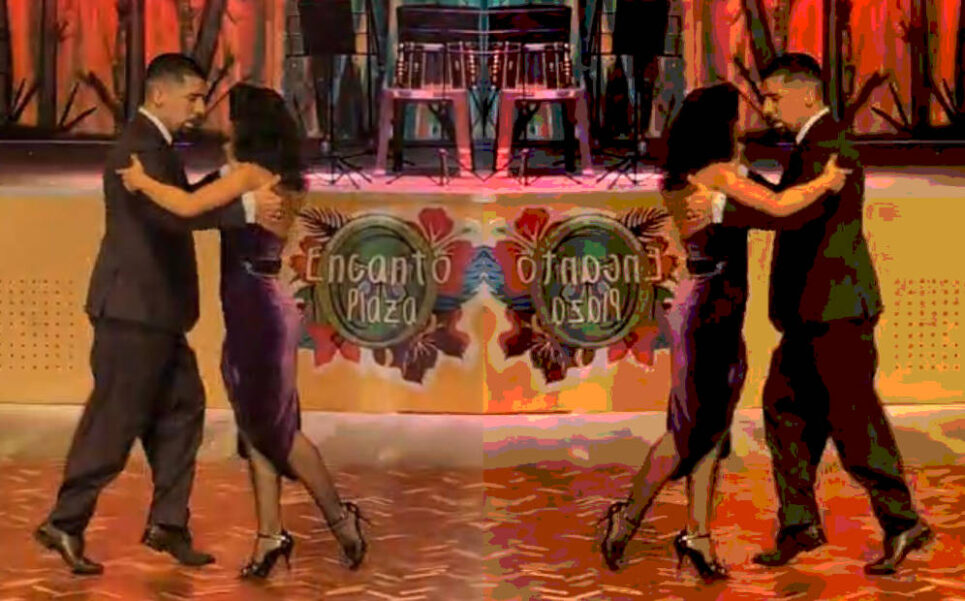
It is important to keep in mind that the tango community in Cali and Colombia has emerged from the desire of people to create entertainment spaces different from those the city offers them. Within this diversity, they find groups of friends, things to do, and activities that take them out of their routine.
The Milongueando Tango Festival 2024 has grown exponentially since its inception. This annual event not only celebrates tango music and dance but also pays tribute to the deep cultural roots that unite Colombia and Argentina.

The 2024 edition had a varied program that included live performances, dance competitions, workshops, and art exhibitions.
The Milongueando Tango Festival has established itself as one of the most important events in the world tango calendar.
Since its inception, the festival’s main objective has been to preserve and promote the roots of traditional tango, while providing a platform for innovation and creativity within the genre.
It also creates a strong community among the participants.
The opportunity to share a passion for tango with other dancers from around the world fosters lasting connections and a sense of belonging.
It was evident to me that organizing an event will always have challenges and many situations to navigate, but it is more bearable when it is something you are passionate about.
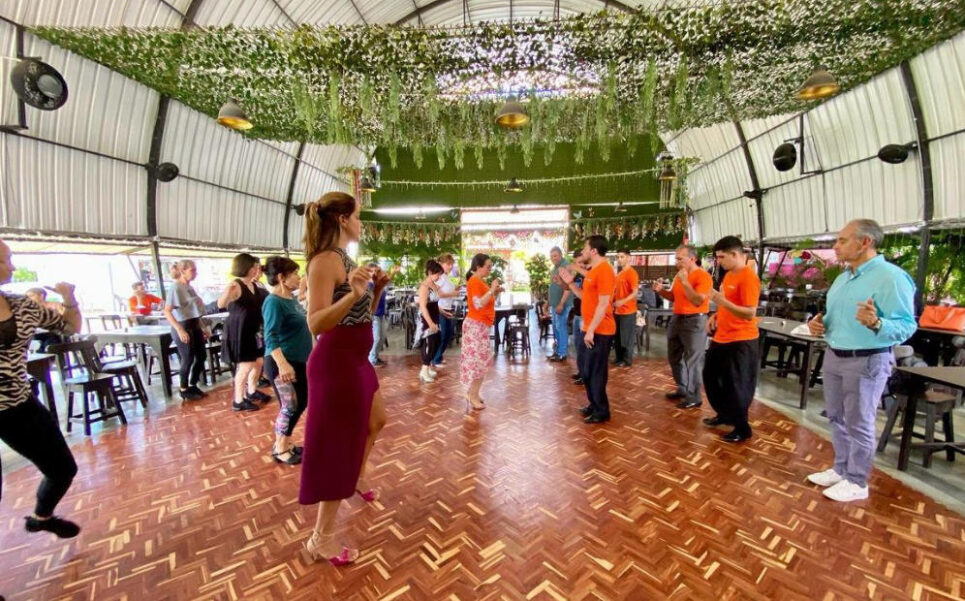
As I was told, this festival was born from the heart of two milongueros passionate about tango and eager to multiply and share this feeling in the city, this makes all the necessary efforts to deliver a quality event to the city bearable.
The festival attendees were tango lovers from all perspectives, from dance, music, community, social activity, and relationships with other like-minded people.
These collaborations have been key to raising the profile of tango in Cali and connecting the local scene with the global tango community.
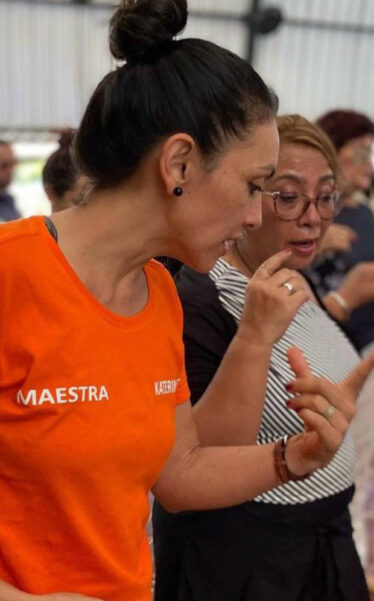
The public enjoyed the programmed activities very much. There were educational workshops and on the other hand, milongas, shows, magic, live music, dinner, and above all a lot of human warmth and a lot of tango.
The workshops took place in the morning. The four workshops that were held were:
Carlos Ochoa and Sofia Ramirez led the workshop on musicality, circularity, and chaining.
They learned to interpret and move to the rhythm of the waltz, mastered turns for a fluid dance, and perfected chains to achieve impeccable choreography.
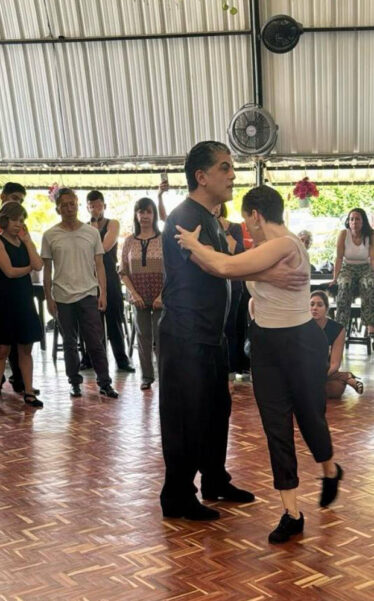
Alejandra Sánchez (a talented Caleña) gave the workshop on rhythmic vs. melodic embellishments.
Participants had the opportunity to delve into the nuances of tango, discovering the differences and complements between the arrangements.
Rubén and Sabrina Veliz conducted the workshop on Turns: positioning and pivoting; working as a team to enhance each role.
Finally, a Master Class was held with all the instructors on musicality: marcato, pulse, and melody.
They learned to mark the beat with precision, discovered how to maintain rhythm and energy in each step, and connected the music so that their dance told a story.
Milongueros from Cali, Bogotá, Armenia, Popayán, Manizales, United States, Brazil, Costa Rica and Puerto Rico participated. During four days, each one enjoyed multiple activities to strengthen their tango and find friendly ties with other people.
The setting: Cali
Cali, with its warm climate and vibrant nightlife, provides the perfect setting for this festival. The city offers a combination of modernity and tradition, with spaces that will be the main meeting points for the festival’s events.
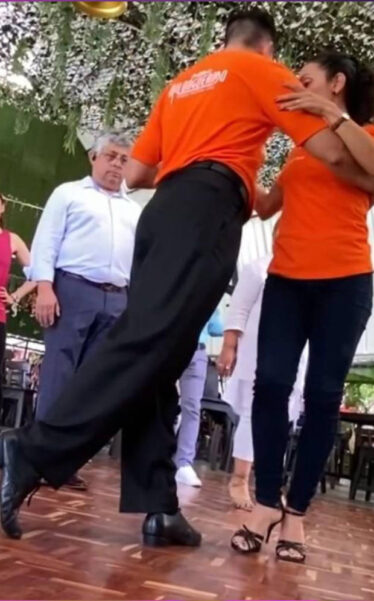
In addition, attendees will have the opportunity to explore the city and enjoy its famous hospitality. Cali’s nights, with their rhythms and colors, will be transformed into a continuous celebration of tango, extending the magic of the festival beyond the official stages.
Solkes: What does it mean for Cali and Colombia to have this type of event in our country?
Milongueando Tango Festival: This type of event allows the promotion and strengthening of local tourism in the city and the country. This event also allows us to show another facet of the city of salsa, generating friendly encounters through a community that is forged with the same sense and the same direction. There is a tango community in Cali and we want more and more people to join this beautiful experience that generates well-being in those who participate in it.
Solkes: Why was the festival held in Cali?
Milongueando Tango Festival: Cali has stood out for being a multicultural city, in that sense tango has an opportunity to activate itself through the existing milonguera community and the events around Argentine rhythms, opening other entertainment possibilities for tourists and locals to enjoy in the city. This is the second edition of the Milongueando Tango Festival, the first one was in June of last year and had a great reception and a very positive response in this city.

Solkes: Where was the event held? Why there?
Milongueando Tango Festival: The event was held at Encanto Plaza. We decided that this place was perfect for our festival since it is a beautiful dome with a large capacity, its owners and staff are wonderful people willing to support cultural activities and we were able to generate an important alliance to develop this event in the city.
Encanto Plaza was transformed into a dream world dedicated to the milonga.
During the festival, four themed milongas were held.
Each of the milongas allowed people to enjoy exhibitions by masters and guest artists, as well as live music by the typical milonga orchestra.
The themed nights were as follows:
*** Milonga Café Tango: inspired by Colombian coffee, with Tango DJ Ferney Gutiérrez.
*** Milonga Colombia Mágica: inspired by Colombian myths and legends, with Tango DJ Andrés Rojas.
*** Milonga Bajo un Cielo Estrellado: inspired by elegance, luxury, and glamour, with Tango DJ Sofia Ramirez.
*** Milonga Cali Vibrante: inspired by the colorful outfits representing the joy of Cali festivities, with Tango DJ Fabio Sánchez.

The themed nights were decided through a creative process with the organizing team, aiming to make the guests explore their creativity through the milonga proposal and thus get involved in the festival in a different way.
This festival featured the participation of prominent national and international artists recognized worldwide. Bogotá was represented by Carlos Ochoa and Sofía Ramírez; Cali was present with Kevin Valencia and Valentina Villarreal, and the teacher Alejandra Sánchez; from Argentina, Katerine Laiton and Joaquín Besga, and the star couple was Rubén and Sabrina Veliz.
As if that weren’t enough, the enthusiasm of the attendees led to the development of a friendly milonga championship.
The perfect complement to impeccable choreographies will always be the traditional orchestra that, with bandoneons, velvety voices, and violins, envelop us in the nostalgia of arrabal rhythms. For this edition of the festival, La Orquesta Típica Milonguera will be performing beautiful songs for two nights.
A festival of this kind not only enriches the cultural life of Cali but also has a significant economic impact.
The influx of tourists and international artists boosts the local economy, generating income for hotels, restaurants, and other businesses. Additionally, the festival promotes cultural exchange and strengthens the bonds between Colombia and other tango-loving countries.
Solkes: What does it mean for Cali and Colombia to have this type of event in our country?
Milongueando Tango Festival: This type of event allows the promotion and strengthening of local tourism in the city and the country. This event also allows us to show another facet of the city of salsa, generating friendly encounters through a community that is forged with the same sense and the same direction. There is a tango community in Cali and we want more and more people to join this beautiful experience that generates well-being in those who participate in it.
The incorporation of tango and milonga into Cali’s cultural life has added a new dimension to the city’s musical identity. Although salsa remains the predominant rhythm, tango has found its own space, coexisting and enriching each other. This musical diversity reflects Cali’s openness and ability to embrace new cultural influences.
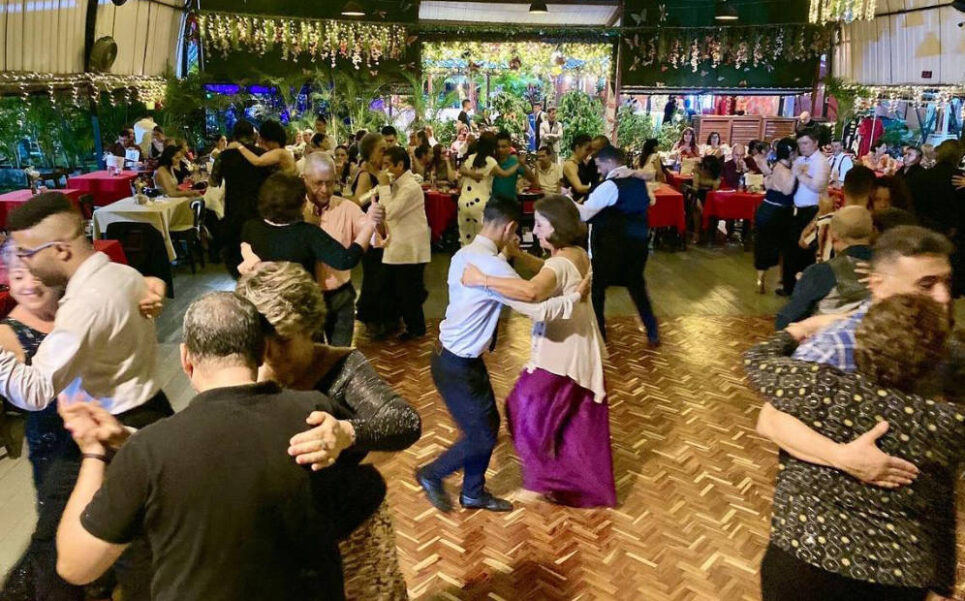
Solkes: What were the highlights of the festival?
Milongueando Tango Festival: The highlights included participation in the training workshops, the performances by dancers and masters, the contribution of the typical milonga orchestra, and the friendly milonga championship that was held.
Milongas and tango events have fostered a strong sense of community among participants. These events are not only opportunities to dance, but also to socialize, establish connections and build friendships. The camaraderie and sense of belonging found at milongas are aspects that many deeply value.
The rise of tango in Cali has also had a positive impact on cultural tourism. Tango festivals and events attract national and international visitors, contributing to the economic and cultural development of the city. Tourists who come for the tango often discover other aspects of Cali’s rich cultural offerings, generating a wider benefit for the city.
Conclusion
The Festival is an extraordinary event that captures the essence of tango and will share it with the world. Between the elegance of the movements, the intensity of the music, and the passion of the participants, Cali was the epicenter of an art that transcends borders and unites hearts.
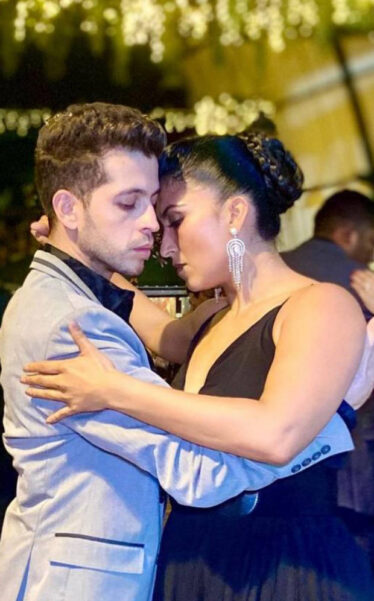
Colombia, known for its cultural diversity and rich musical heritage, has developed a special relationship with tango over the years.
Although tango originated in the Río de la Plata, in Argentina and Uruguay, it has found a second home in Colombia, where it has been adopted with passion and fervor.
This tradition, deeply rooted in cities such as Medellín and Bogotá, is testimony to the ability of music and dance to transcend borders and bring people together.
Milonga in Cali has come a long way from its humble beginnings. Today, it is a vibrant and dynamic part of the city’s cultural scene, offering Cali residents and visitors a way to connect with the rich tradition of tango. With its continued growth and its ability to attract a diverse and passionate community, milonga in Cali promises to remain an important and beloved cultural expression for years to come.


